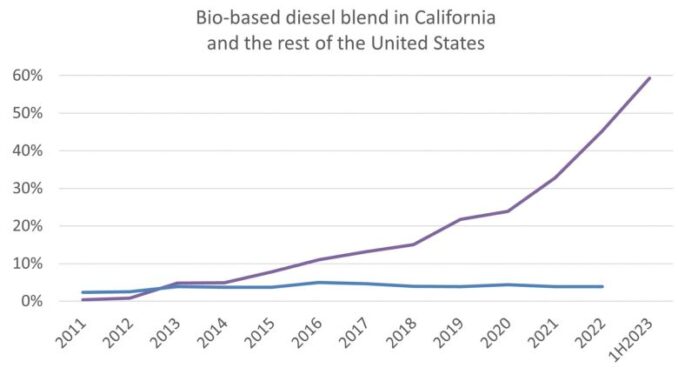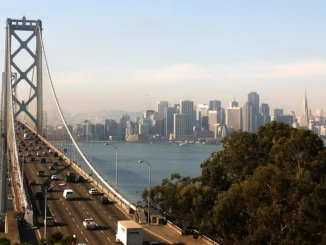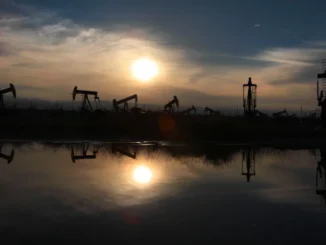
This story was originally published by Canary Media.
One of California’s marquee programs for cleaning up transportation emissions is at a crossroads. Decisions made in the next few months could set the decade-and-a-half-old Low Carbon Fuel Standard on one of two very different paths.
One path, favored by fossil fuel and renewable natural gas interests, would lock in a market scheme that currently extracts billions of dollars per year from Californians at the pump and subsidizes crop-based and cow-manure-derived biofuels.
That would be a disaster, according to environmental advocates, who point to a growing body of scientific evidence showing that this approach, if extended until 2045 as proposed, would cause these biofuels to grow at a scale that would harm the climate and the environment.
The other path, proposed by environmental groups, transportation-decarbonization analysts and climate and energy researchers, would limit the scope of unsustainable biofuels in the program, and instead reorient it to support what experts agree should be California’s primary clean transportation pathway: electric vehicles.
To date, roughly 80 percent of LCFS funding has gone to combustion biofuels rather than electric vehicles. That’s simply incompatible with the state’s EV ambitions and needs, said Adrian Martinez, deputy managing attorney of nonprofit advocacy group Earthjustice — and the imperative to reduce emissions from transportation, which account for nearly 40 percent of the state’s greenhouse gas emissions.
“We’ve got to eliminate our reliance on combustion,” he said, but “the program as designed will continue to provide lucrative incentives for combustible fuels well into the future.”
The regulator in charge of the LCFS program — and this high-stakes decision — is the California Air Resources Board. CARB’s board, which comprises 14 voting members, 12 appointed by the governor and two by the state legislature, holds a host of responsibilities around California’s energy transition. Those include shaping the state’s nation-leading EV policy, as well as determining its broad plans for achieving long-term greenhouse-gas reduction goals.
Critics say the LCFS program’s increasing support for biofuels is in direct contrast to both the EV targets and the climate goals also overseen by CARB — and that the program has been captured by deep-pocketed industries trying to greenwash the continued use of combustion fuels.
CARB has a chance to reform the program with an upcoming vote, initially set for this month, but now postponed to an undetermined future date. But its pathway to fixing the problems that plague LCFS is murky and messy at best.
Right now, the staff managing the LCFS program hasn’t given CARB board members an opportunity to pick a climate- and EV-friendly alternative. Instead, a December staff proposal provides only one option for the board to vote on later this year: a set of policies that Earthjustice forecasts would direct $27 billion over the coming decade toward biofuels and worsen effects on the climate, the environment and the prices that Californians pay at the pump.
CARB does have another option, however — an alternative proposal laid out by CARB’s Environmental Justice Advisory Committee, created to advise the board on environmental-justice issues.
That proposal would cap the fast-growing share of crop-based renewable diesel flooding the state. It would also end the unusual structure that now allows biogas produced by dairy farm manure to offset a much higher amount of carbon emissions than any other source of alternative fuels.
And, importantly, it would make the core of the program — its carbon-offset marketplace — function in a much healthier way, proponents say. A torrent of cheap, polluting renewable diesel and dairy farm biogas credits have dragged down the price that LCFS credits can fetch for avoiding emissions, diluting the incentive to deploy new climate technologies and sapping what could be a key funding source for EV infrastructure in the state.
“The stakes are very, very high,” Martinez said. “That’s why you see so much attention focused on this — and a very broad and diverse coalition that is pushing for more systemic change to the program, versus more modest tweaks that will really just keep this market owned and dominated by fossil fuel interests.”
California’s Low Carbon Fuel Standard was born out of AB 32, the 2006 law that created the state’s carbon cap-and-trade market. Much like carbon markets, LCFS is meant to make companies pay for their carbon emissions by buying credits from technologies that reduce carbon emissions.
The program requires all fossil fuels refined and sold in California to meet increasingly stringent carbon-intensity targets. In practice, fossil fuel producers have to buy a bunch of LCFS credits from low-carbon transit sources operating in the state in order to comply. The goal is to create a system that taxes planet-warming fossil fuels to fund cleaner transportation alternatives.
But the LCFS has strayed from its initial focus on vehicle electrification and “advanced” non-crop-based biofuels to become “a swag bag for venture capitalists, big oil, big agriculture, and big gas, increasingly coming at the expense of low- and moderate-income Californians.” That’s how Jim Duffy, a 13-year veteran of the agency who served as branch chief of the LCFS program from 2019 to 2020 and retired in 2022, described the evolution of the program in comments filed with CARB.
Under the LCFS regulation adopted in 2009, dairy-manure-to-biogas projects did not receive special treatment compared to other sources of methane such as landfills and sewage treatment plants, Duffy wrote. Similarly, diesel fuels made from crops like soybeans were considered “only marginally better than fossil diesel.”
But in the years since, “the LCFS was revised to provide additional and unnecessary support to landfills and first-generation crop-based biofuels” and “to mitigate the methane problem created by the dairy industry itself,” Duffy wrote — despite the fact that evidence increasingly suggests that both sources harm the planet far more than they benefit it.
The result has been an increasing share of LCFS credits being supplied by renewable diesel and dairy-generated biogas.
(CARB)
CARB has justified these shifts with analysis indicating they will yield net positive climate impacts.
“The proposed amendments now under consideration will directly increase the program benefits in the most burdened communities, by reducing the carbon across the supply chain for fuels sold in California, as well as improving public health for fuels sold in California,” CARB spokesperson Dave Clegern said in an email to Canary Media. He cited data from CARB staff’s analysis of its proposal indicating that, by 2045, its plan will reduce nitrogen oxide emissions by 25,586 tons, cut greenhouse gas emissions by 560 million metric tons and yield public-health cost savings of nearly $5 billion.
But critics say the agency is failing to account for the full scope of climate harms that will be caused by its continued emphasis on biofuels.
They warn that the sheer scale of California’s program — totaling some $4 billion per year — is driving investment in the wrong transportation alternatives. The consequences are dire, they say — not just within the state, but across the country and around the world.
Take renewable diesel, a fuel made from fats and oils processed to be identical to fossil diesel fuel. The U.S. increased production of the fuel by 400% between 2019 and 2022, and it is set to double it again this year, according to Jeremy Martin, senior scientist and director of fuels policy for the Union of Concerned Scientists.
Unlike ethanol and biodiesel, which can only partially replace gasoline and diesel, renewable diesel has “no limit on how much can be blended,” Martin said. It could theoretically completely replace diesel fuel for trucks, buses and other vehicles. And California’s LCFS offers credits on top of the federal incentives the fuel receives, making the state the primary target of renewable diesel producers across the country.
As a result, the share of renewable diesel as a percentage of total diesel fuel use has skyrocketed in California compared to the rest of the U.S., as the chart below shows.
(Union of Concerned Scientists)
In a September meeting, Steven Cliff, CARB’s executive officer, highlighted a milestone for the LCFS program: As of mid-2023, California had “more than half of our diesel demand being met by non-petroleum-based diesel alternatives. This is a direct result of the LCFS program, and it’s bringing real climate and air-quality benefits to the state.”
In Martin’s view, that milestone is not a win, but a warning. It indicates that renewable diesel is “flooding the LCFS, drowning the policy — and it doesn’t make sense” on climate or environmental terms.
Once the demand for renewable diesel outgrows the supply of waste oils and other non-crop feedstocks that can be used to make the fuel in genuinely climate-friendly ways, it becomes highly likely that it will cause more greenhouse gas emissions than it will displace. Critics like Martin argue that demand has now reached this point, though it’s a contested question.
This additional demand for crop oils could mostly serve “to expand the cultivation of palm oil to replace the soybean and other oils made into fuel,” the Union of Concerned Scientists argued in comments to CARB. That, in turn, is likely to lead to more rapid deforestation in nations that produce large amounts of these crops, such as Brazil and Indonesia — an outcome that would cause far greater climate harms than whatever emissions reductions result from replacing fossil diesel.
To stop this, the Union of Concerned Scientists and other groups want CARB to set a limit on how much renewable diesel can receive LCFS credits. CARB staff’s proposal declines to set such a cap, citing renewable diesel’s climate and health benefits.
But CARB’s methodology is out of step with the latest science, according to multiple groups studying these issues. The Union of Concerned Scientists, for its part, says CARB’s analysis is “based on inaccurate claims of climate and air-quality benefits and associated health outcomes.”
In a recent comparison of five different models for evaluating the climate impacts of crop-based biofuels, the U.S. Environmental Protection Agency found that only CARB’s own model shows a positive carbon-reduction impact.
And while the agency has a proposal to limit deforestation harms by setting “sustainability guidelines” for crops being used for renewable diesel, it applies only to feedstocks grown in the U.S., Martin noted. That’s a problem: California is on pace to consume 10 percent of global soybean oil supplies for renewable diesel, meaning a significant amount of the crop oil produced for the program will be grown under conditions CARB cannot police, he said.
Given that reality, Martin said, “If California declines to act — if they say, ‘This is evidence of success; look how little fossil diesel we’re using’” by replacing it with renewable diesel, “then, in fact, California is giving its support to a fuel that we know is unsustainable at these volumes.”



